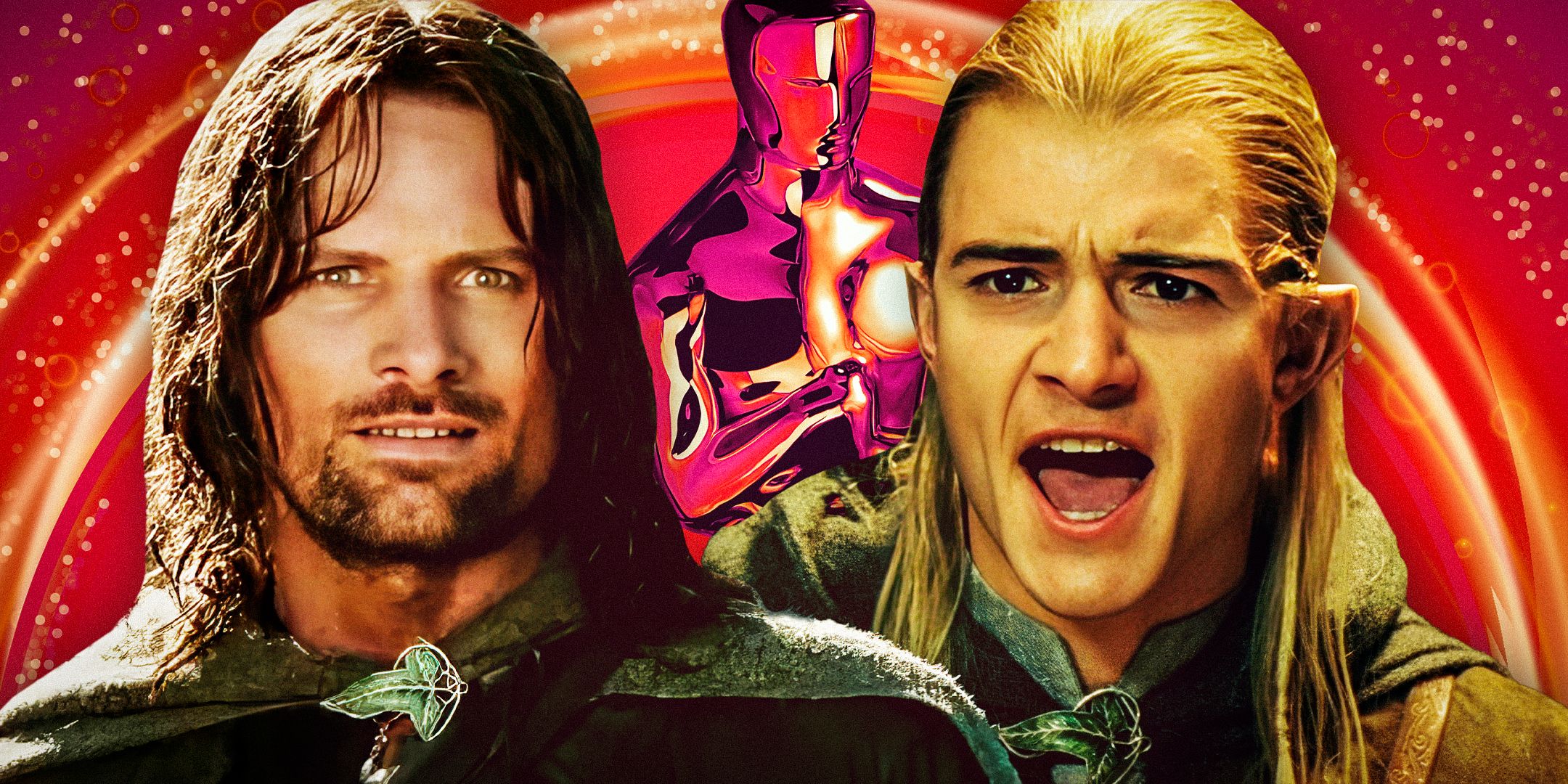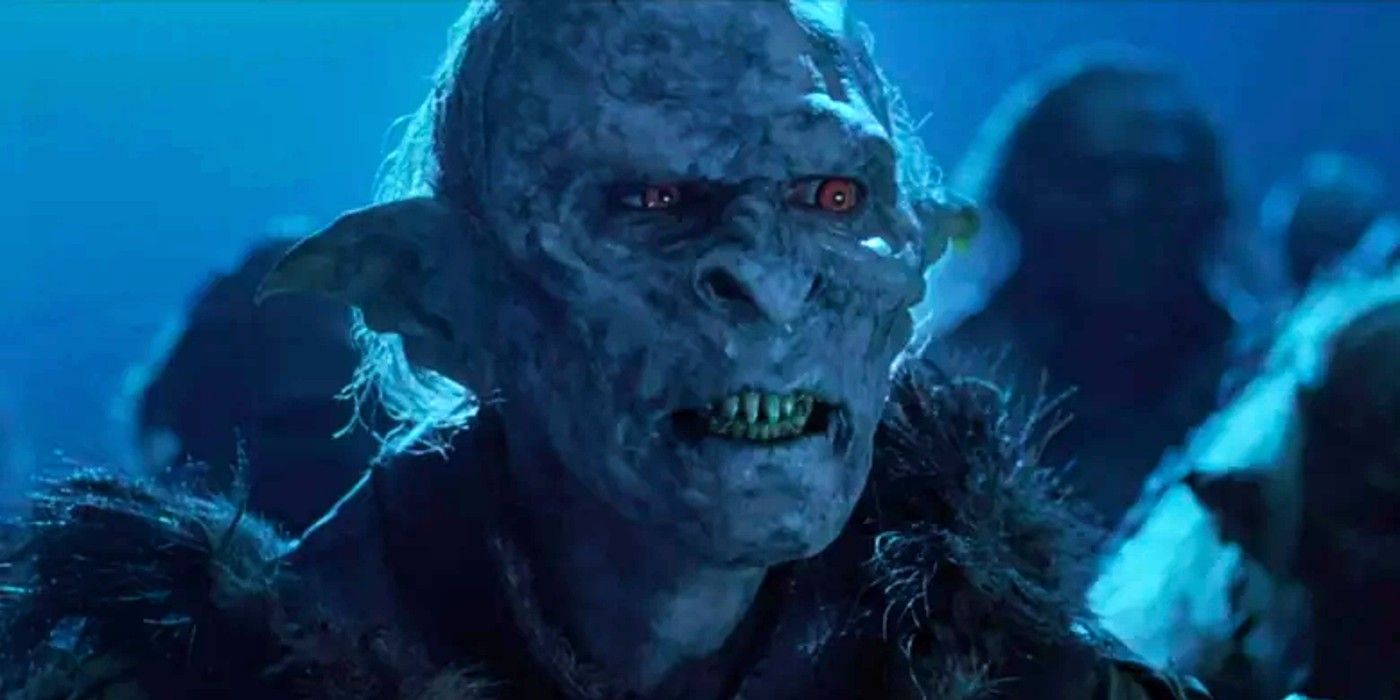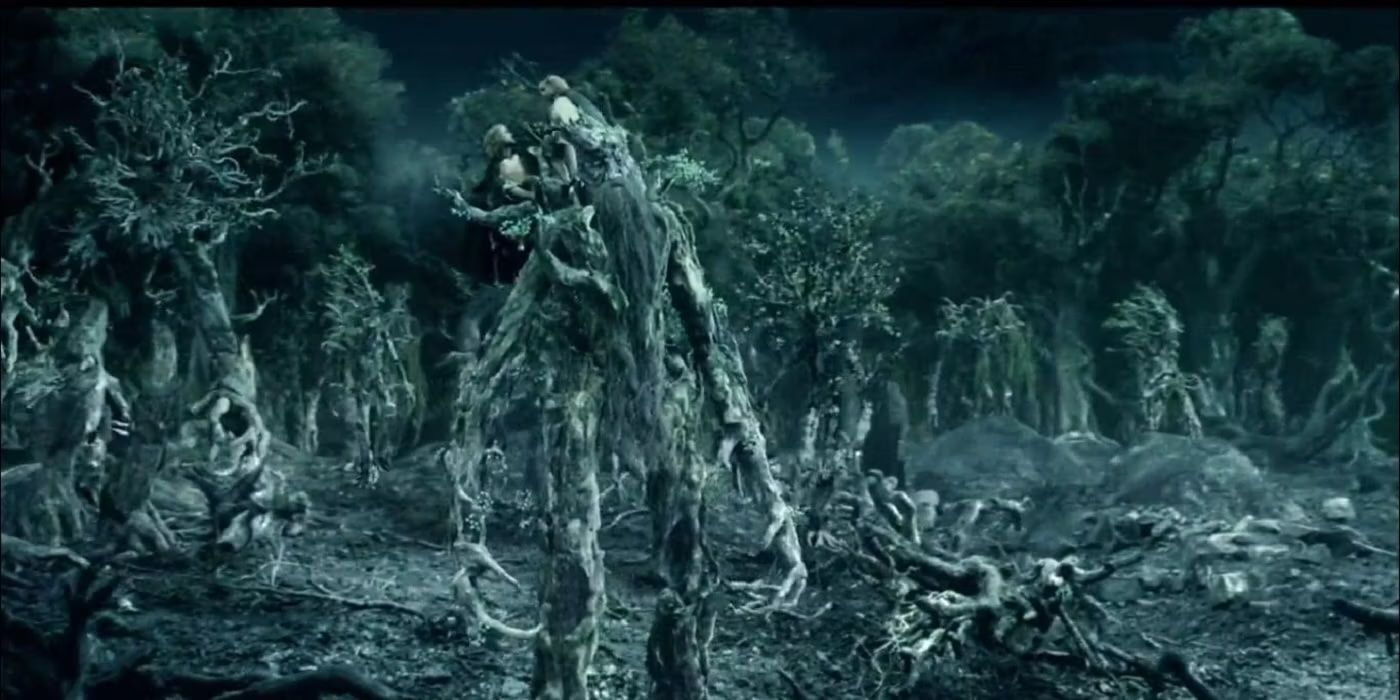
While The Two Towers isn’t favorably compared to the installments that preceded and followed it, the sequel also faced significant competition from other movies at the 75th Academy Awards. This was a year when one of the best movie musicals to win Best Picture arose, as well as another Martin Scorsese crime drama. Therefore, a handful of movies competed with The Two Towers in almost every category for which it was nominated.
Ultimately, The Two Towers is still a landmark fantasy and action movie that showed Jackson breaking down genre boundaries by earning another shot at the top award in Hollywood. Other major fantasy action movies came out in 2002 and were nowhere near as acclaimed, making their own bids for maybe one award at the Oscars. Meanwhile, The Two Towers remains a vital part of one of the best fantasy movies of all time.
Best Visual Effects (Winner)
The Two Towers Won Best Visual Effects Thanks To Gollum & Treebeard










Lord of the Rings changed the fantasy genre forever with its sheer scale, but also made its noteworthy contribution to the advancement of special effects, building upon the work of VFX artists in the 1990s. Following The Lord of the Rings: The Fellowship of the Rings winning in the same category the year before, The Two Towers again won Best Visual Effects. Overall, Lord of the Rings are older movies with special effects that hold up very well.
Movie
Nominees
The Lord of the Rings: The Two Towers (winner)
Jim Rygiel, Joe Letteri, Randall William Cook, & Alex Funke
Spider-Man
John Dykstra, Scott Stokdyk, Anthony LaMolinara, & John Frazier
Star Wars Episode II: Attack of the Clones
Rob Coleman, Pablo Helman, John Knoll, & Ben Snow
The Two Towers meant special effects again being used for the Nazgûl and their mounts, the Balrog, and general Middle-earth wizard magic. However, new beings such as the Ents had to be rendered on-screen, while wider shots of the Nazgûl would also have been challenging. All the new elements in The Two Towers seamlessly live up to the movie’s predecessor, most monumentally with the additional screentime given to Andy Serkis as Gollum, still constituting some of the most impressive CGI ever done.
A surprising amount of Lord of the Rings was accomplished with practical effects: Jackson famously relied on forced perspective shots to create the different heights between the Hobbits, dwarves, elves, and humans, while the Orcs’ appearance is created with prosthetics and makeup, before using more CGI in the Hobbit movies. Yet these movies would not have been possible without the VFX team doing Oscar-worthy work, earning them this Oscar three years in a row.
Best Sound Editing (Winner)
The Two Towers’ Editors Layered The Sounds Of Battle, Dialogue, & Music










The sound categories have since been merged into one award at the Oscars, but sound editing used to be specifically awarded to crew members who specialized in manipulating the various sounds at play in any given scene. Composers are in charge of the movie’s score, but sound designers must render the sounds of shouts, explosions, weapons clashing, and so on. From Helm’s Deep to Gollum’s solitary monologues, the sound editors altered voices and background noise to the best effect.
Movie
Nominees
The Lord of the Rings: The Two Towers (winner)
Ethan Van der Ryn & Michael Hopkins
Minority Report
Richard Hymns & Gary Rydstrom
Road to Perdition
Scott A. Hecker
Minority Report and Road to Perdition both also saw additional nominations this year. In the case of Minority Report, it is easy to understand how the sci-fi action adventure also garnered a nomination for sound editing. Less obvious is the work done on the crime drama and psychological thriller Road to Perdition. However, neither offered significant competition to The Two Towers. Notably, Chicago was not even nominated in this category.
The Lord of the Rings: The Fellowship of the Ring won four Oscars in 2002, while The Lord of the Rings: The Return of the King won 11 Oscars in 2004.
However, Best Sound Editing is the only other Oscar The Two Towers won, in what was ultimately a down year for Lord of the Ringsbefore The Lord of the Rings: Return of the Kings’ sweep in 2004. Elements like special effects and sound might be considered “soft” categories at the Oscars, which are often more open to blockbuster movies. However, the Lord of the Rings movies are true masterpieces because all the work that went into them is Oscar-worthy.
Best Sound
The Two Towers’ Creation Of Sound Lost Out To A Musical Spectacular










In creating sound from scratch, The Two Towers also delivered. The epic score must come in at the right time, there are sounds accompanying magic and Orcs charging into battle, and the team is working with the actors to create amazingly heroic moments or hype up a perfect fantasy movie villain performance. The process of sound mixing refers to layering sounds; this means numerous massive battle sequences where the shouting and general chaos of the conflict, the important dialogue, and the score must be acutely balanced.
Movie
Nominees
Chicago (winner)
Michael Minkler, Dominick Tavella, & David Lee
Gangs of New York
Tom Fleischman, Eugene Gearty, & Ivan Sharrock
The Lord of the Rings: The Two Towers
Christopher Boyes, Michael Semanick, Michael Hedges, & Hammond Peek
Road to Perdition
Scott Millan, Bob Beemer, & John Patrick Pritchett
Spider-Man
Kevin O’Connell, Greg P. Russell, & Ed Novick
However, The Two Towers faced an insurmountable obstacle in the sound category when it was competing with a movie musical. Chicago dominated the Oscars the year it won Best Picture, and sound was only the beginning. As amazing as Lord of the Rings is, the first musical number of Chicago demonstrates how perfectly the team behind that movie transitioned the Broadway musical to the screen. The jazz instruments punctuate each moment perfectly, making Catherine Zeta-Jones’ entrance dazzling.
Fellowship of the Ring also lost Best Sound, while Return of the King finally won Best Sound Mixing (the category definitions being altered slightly from year to year). Sound was vital to rendering Middle-earth, but what makes for the truly great sound is hard to describe. In the case of this year’s Oscars, there was another movie where sound was at the forefront as a musical adaptation.
Best Film Editing
The Two Towers Moves Seamlessly Through Battles & Different Locations










Similar to the sound categories, with film editing, if it is being done well, the average audience member probably doesn’t notice it. They are too busy being immersed in the overall world, which is an interaction between the various elements of sound, editing, design, acting, and so on. With The Two Towers, the editors are responsible for arranging footage in sequence so that the chaotic battle scenes flow, making for the optimal viewing experience.
Movie
Nominee
Chicago (winner)
Martin Walsh
Gangs of New York
Thelma Schoonmaker
The Hours
Peter Boyle
The Lord of the Rings: The Two Towers
Michael Horton
The Pianist
Hervé de Luze
The Two Towers also changes perspectives throughout the movie; while scene-to-scene changes are bigger and require more direction from the writers on how they want the story to progress, cutting between two different places is still an important editing task. Notably, the Two Towers book focuses entirely on Frodo and Sam for one half, while covering the rest of the Fellowship in the other half; Jackson and his team completely reworked the narrative.
However, Chicago also pulled off an impressive adaptation feat where the editing was concerned, having the characters perform their musical numbers in a kind of alternate reality, singing on a glitzy stage while they move through a prison at the same time. Editing between two performances of the same song in multiple places was ambitious but worked perfectly for Chicago. The Two Towers was mostly doing what other action movies had done before it.
Best Art Direction-Set Decoration
Middle-earth’s Settings Are Always Breathtaking










Every Lord of the Rings movie’s art direction/production design is stunning. For this category, there is a clear trend where the Academy seems to have predetermined which year it is going to favor Jackson, simply because it’s the year when they are going to win everything. Then again, the similarities between the two movies Fellowship of the Ring and The Two Towers lost to suggest that the Academy genuinely considers a certain type of set design more impressive. Fellowship of the Ring lost to Moulin Rouge!; The Two Towers lost to Chicago.
Movie
Nominees
Chicago (winner)
Art direction: John Myhre; set decoration: Gordon Sim
Frida
Art direction: Felipe Fernandez del Paso; set decoration: Hania Robledo
Gangs of New York
Art direction: Dante Ferretti; set decoration: Francesca Lo Schiavo
The Lord of the Rings: The Two Towers
Art direction: Grant Major; set decoration: Dan Hennah & Alan Lee
Road to Perdition
Art direction: Dennis Gassner; set decoration: Nancy Haigh
Pertaining to the second Lord of the Rings movie, the art and set designers were charged with the locals of Rohan, Helm’s Deep, parts of Mordor, and the open plains of Middle-earth. Some of this is simply the spectacular scenery of New Zealand, where the movies were filmed. However, it is enhanced in key places, while impressive sets are constructed for the fictional world’s architecture.
The Fangorn Forest and Helm’s Deep are the two most awesome feats of production design that aren’t in the other two Lord of the Rings movies. The former is soothing, but still foreboding, considering the secrets it holds. The Ents instill it with this characterization, but the design stands on its own. Meanwhile, Helm’s Deep is a complicated setting given how much action takes place there but it is believable as both a formidable fortress and a place in dire danger.
Best Picture
Fellowship Of The Ring & The Two Towers Set Up The Best Picture Nomination Streak










Lord of the Rings lost Best Picture once to A Beautiful Mind and again to Chicagobefore it finally took home the grand prize the third time around. Looking at The Two Towers completely outside the context of being a bridge between the beginning and the end, it is, of course, a stellar movie. All the disparate elements are working together to create an epic experience, while different beats in Lord of the Rings’ overall themes of endurance, bravery, and fellowship appear.
Movie
Nominees
Chicago (winner)
Martin Richards (producer)
Gangs of New York
Alberto Grimaldi & Harvey Weinstein (producers)
The Hours
Scott Rudin & Robert Fox (producers)
The Lord of the Rings: The Two Towers
Barrie M. Osborne, Fran Walsh & Peter Jackson (producers)
The Pianist
Roman Polanski, Robert Benmussa & Alain Sarde (producers)
The Two Towers covers more ground, both with story and themes, when the Fellowship isn’t required to be together. It shows doubt and fear overcoming the characters in different ways when they are in different circumstances. Motifs of the heavy weight of duty are elevated by new characters like Faramir and Éowyn, facing their own obstacles in this regard. However, many of these subplots aren’t fully resolved when every individual storyline still has another movie.
The Lord of the Rings: The Two Towers boats some individual moments that can’t compare to their arguable counterparts in other movies. Serkis’ performance as Gollum is at its best when he gets his longest sequence on screen alone, and the Helm’s Deep battle only happens once. While other Lord of the Rings moments may be better, they are doing something different from the franchise’s sophomore installment, which led a valiant campaign at the Oscars when it simply wasn’t this series’ year.


